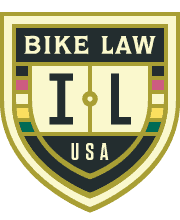It’s important to know your legal rights (and duties) when bicycling in Illinois. It is especially important after a bicycle accident (we call them bicycle “crashes” and explain why here).
This is a general overview of Illinois’s bicycle laws. To see them in their completion, please visit Illinois’ Department of Transportation. Feel free to reach out to Bike Law’s National Director Rachael Maney for further information.
Right to the Road
- Bicycles are not defined as vehicles but generally have the same rights and responsibilities as motor vehicle drivers.
Where to Ride
- Bicyclists are required to ride as close as practicable to the right hand edge of the roadway, when traveling at less than the speed of traffic.
- Full lane use is allowed when traveling at the normal speed of traffic, preparing for a turn, overtaking and passing, avoiding hazards, traveling in a lane too narrow to share or a one-way highway, and avoiding a mandatory turn lane.
- Bicyclists may (but are not required to) utilize any usable path for bicycles that has been provided adjacent to a roadway.
- Bicycles are prohibited from being ridden on the sidewalks. Check local ordinances for variations on this rule.
- No person may open the door of a motor vehicle unless it is safe to do so.
HOW TO RIDE
- Bicyclists shall not ride more than two abreast, except on bike paths, and may not impede motor vehicle traffic. Check local ordinances for variations on this rule, as some municipalities require single file riding.
- Bicyclists are required to slow down and come to a complete stop at stop signs and traffic devices signaling red. In some municipalities outside of Chicago, bicyclists may proceed through a red signal that fails to change to green (“dead red”) after yielding to oncoming traffic. Check local ordinances for variations on this rule.
- Bicyclists must signal when turning or coming to a stop.
Bicyclists Overtaking Cars
- Bicyclists on roadways must exercise due care when passing a standing vehicle or one proceeding in the same direction.
Cars Overtaking Bicyclists
- Motor vehicle drivers are required to pass bicyclists with at least three (3) feet clearance.
- Motor vehicle drivers may not drive recklessly near or unnecessarily close to bicyclists. If doing so causes bodily harm or death to the bicyclist, the driver may be found guilty of a felony.
Equipment
- At night, a bicycle must be equipped with a front white light and a rear red reflector or light, both visible from at least 500 feet away.
- Every bicycle must have brakes which adequately controls the movement and stop and hold of the bicycle.
- There is no statewide requirement for helmet use though some municipalities in Illinois require helmet use by children.
Prohibitions
- Clinging to motor vehicles while bicycling is not permitted.
- A bicycle may not carry more than the number of persons for which it is designed, except an adult rider carrying a child securely in a backpack or sling.
- Bicyclists may not ride other than upon or astride a permanent attached regular seat.
- Bicyclists may not carry any package which prevents both hands from being in control of the operation of the bicycle. One hand must be on the handlebars at all times.
- Bicycles shall not be equipped with any siren.
- Bicycle racing is prohibited except when approved by the State or local authorities.
Police Inspection of Bicycles
- A uniformed police officer may stop and inspect a bicycle at any time upon reasonable cause that the bicycle is unsafe or not equipped as required by law.
Alcohol
- Illinois’s DUI statute does not apply to bicyclists and the state does not have a biking while under the influence (BUI) statute.
Electric Assist Bikes
- Illinois has implemented a three-class system for electric assist bikes (“e-bikes”). An e-bike must have operable pedals and an electric motor of less than 750 watts. A Class 1 e-bike is one “that provides assistance only when the rider is pedaling and that ceases to provide assistance when the bicycle reaches a speed of 20 mph.” A Class 2 e-bike is one that does not necessarily require the rider to pedal to activate the motor. Rather the motor may be used exclusively to power the bike, but ceases when the bike hits 20 mph. A Class 3 e-bike, like a Class 1 bike, provides assistance only when the rider pedals, but ceases once it hits 28 miles per hour.
- Generally, bicyclists may use a Class 1 e-bikes in the same manner as traditional bicycles. A rider must be at least 16 years of age to ride a Class 3 e-bike.
